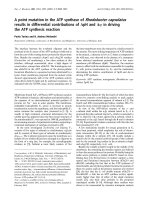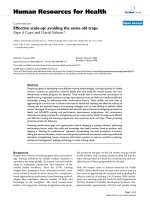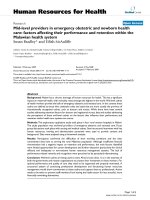báo cáo sinh học:" Non-European Union doctors in the National Health Service: why, when and how do they come to the United Kingdom of Great Britain and Northern Ireland?" pdf
Bạn đang xem bản rút gọn của tài liệu. Xem và tải ngay bản đầy đủ của tài liệu tại đây (215.22 KB, 6 trang )
BioMed Central
Page 1 of 6
(page number not for citation purposes)
Human Resources for Health
Open Access
Research
Non-European Union doctors in the National Health Service: why,
when and how do they come to the United Kingdom of Great
Britain and Northern Ireland?
Jyothis T George*
1
, Kavitha S Rozario
2
, Jeffrin Anthony
3
, Edward B Jude
4
and
Gerard A McKay
5
Address:
1
York District Hospital, York, YO31 8HE, United Kingdom of Great Britain and Northern Ireland,
2
Harrogate District Hospital, Harrogate,
North Yorkshire, HG2 7SX, United Kingdom of Great Britain and Northern Ireland,
3
Walsgrave Hospital, Coventry, CV2 2DX, United Kingdom
of Great Britain and Northern Ireland,
4
Tameside General Hospital, Ashton-under-Lyne, OL6 9RW, United Kingdom of Great Britain and Northern
Ireland and
5
Monklands Hospital, Airdrie, ML6 0JS, United Kingdom of Great Britain and Northern Ireland
Email: Jyothis T George* - ; Kavitha S Rozario - ; Jeffrin Anthony - ;
Edward B Jude - ; Gerard A McKay -
* Corresponding author
Abstract
Background: As many as 30% of doctors working for the National Health System (NHS) of the
United Kingdom of Great Britain and Northern Ireland (UK) have obtained their primary
qualifications from a country outside the European Union. However, factors driving this migration
of doctors to the UK merit continuing exploration. Our objective was to obtain training and
employment profile of UK doctors who obtained their primary medical qualification outside the
European Union (non-European doctors) and to assess self-reported reasons for their migration.
Methods: We conducted an online survey of non-European doctors using a pre-validated
questionnaire.
Results: One thousand six hundred and nineteen doctors of 26 different nationalities completed
the survey. Of the respondents, 90.1% were from India and over three-quarters migrated to the
UK mainly for 'training'. Other reasons cited were 'better pay' (7.2%), 'better work environment'
(7.1%) and 'having family and friends in the UK' (2.8%). Many of the respondents have been in the
UK for more than a year (88.8%), with 31.3% having spent more than 3 years gaining experience of
working in the NHS. Most respondents believe they will be affected by recent changes to UK
immigration policy (86.6%), few report that they would be unaffected (3.7%) and the rest are
unsure (9.8%).
Conclusion: The primary reason for many non-European doctors to migrate to the UK is for
training within the NHS. Secondary reasons like better pay, better work environment and having
friends and family in the UK also play a role in attracting these doctors, predominantly from the
Indian subcontinent and other British Commonwealth countries.
Published: 27 February 2007
Human Resources for Health 2007, 5:6 doi:10.1186/1478-4491-5-6
Received: 8 October 2006
Accepted: 27 February 2007
This article is available from: />© 2007 George et al; licensee BioMed Central Ltd.
This is an Open Access article distributed under the terms of the Creative Commons Attribution License ( />),
which permits unrestricted use, distribution, and reproduction in any medium, provided the original work is properly cited.
Human Resources for Health 2007, 5:6 />Page 2 of 6
(page number not for citation purposes)
Background
The National Health Service is the public sector organisa-
tion providing state-funded healthcare in the United
Kingdom and Great Britain. As many as 30% of its doctors
have been trained outside the Europe [1]. In some regions,
overseas doctors comprise up to 50% of all junior doctors
[2]. General Medical Council (GMC), the United King-
dom's regulatory and licensing body for doctors, had a
total of 239 661 doctors registered with it on 1 June 2006,
22.8% (n = 54 656) obtained their primary medical qual-
ification outside the European Union.
UK government policy towards non-European Union
(non-EU) doctors was changed recently [3]. Non-EU resi-
dents normally require a work-permit to take up any
employment in the UK. Until recently, doctors in training
posts were exempt through a special scheme called per-
mit-free training (PFT). With the new changes to immigra-
tion policy, NHS employers wishing to appoint these
doctors will have to prove that no suitable European
Union applicants are available. This may result non Euro-
pean doctors being unable to compete for NHS jobs. The
number of doctors affected by this is estimated to be
between ten thousand [4] and sixteen thousand [5]. It is
in this context that we undertook the study. Our objective
was to provide a self-reported training and employment
profile of non-European doctors in the UK and to assess
self-reported reasons for their migration.
Methods
We established an online survey using a pre-validated
questionnaire. Validation was carried out with a repre-
sentative test cohort with feedback from leaders of non-
European doctors' organizations. The survey sample was
defined as all doctors in the UK who obtained their pri-
mary medical qualification outside the EU. Email invita-
tions were sent to various organizations of overseas
doctors. Respondents were requested to recommend the
survey to other non-EU doctors using a pre-programmed
input area on our webpage to ensure maximum reach
among our target sample.
Programming tools were used to prevent duplicate sub-
missions and registration numbers with the General Med-
ical Council were used as unique markers.
The survey was open for submission for four consecutive
weeks ending 22 April 2006.
Results
We received one thousand six hundred and nineteen com-
pleted responses from doctors of 26 different nationali-
ties. This represents 2.96% of all non-European Union
doctors registered with the GMC. Those of Indian nation-
ality represented 90.1%, followed by Pakistan (2.7%),
Nigeria (0.9%), Sri Lanka (0.7%), Bangladesh (0.4%) and
South Africa (0.4%). All other 21 nationalities added up
to a further 4.1%.
The country where respondents obtained their primary
qualification mirrors nationality profile. Respondents
qualified in India represented 90.1%, 2.8% in Pakistan,
1.1% in Nigeria, 0.5% in South Africa along with 0.4%
each in Bangladesh and Sri Lanka. Twelve doctors (less
than 0.01%) of non-EU nationality with UK undergradu-
ate medical training also responded to the study. We used
these responses in the analysis, but this negligible group
of responses does not affect the overall statistics in any
meaningful manner.
All respondents were asked to report the year of primary
medical qualification. From 1995 onwards, there was a
steady rise, with 4.4% qualifying in 1995, 6.7% in 1996,
8% in 1997, 8.9% in 1998, 10.3% in 1999 and 12.5% in
2000. There was a levelling out in 2001 (12.3%) and 2002
(11.2%), but thereafter a drop, with 7.7% qualifying in
2003, 4% in 2004 and 0.9% in 2005 (Figure 1).
The respondents were asked to report the duration of time
they had spent in the UK. Twenty five percent had been in
the UK for more than 1 year but less than 2 years, 27% had
spent 2 to 3 years, 16.5% had been in the UK for 3 to 4
years, 7.1% had spent between 4 and 5 years, 11.3% had
spent between 5 and 10 years, and 2% had spent more
than 10 years. Those who had spent less than one year in
the UK amounted to 11.2% (Figure 2).
Of the respondents, 88.9% had held a paid NHS post,
while the remaining 11.1% had been unemployed
throughout their stay in the UK. Of all the respondents,
12.9% were currently unemployed, suggesting some had
failed to secure further employment even after obtaining
a paid post in the NHS. At the time of reporting, there
were 48% of our respondents employed in junior training
posts (foundation trainees, Senior House Officers or
House Officers), 17.8% in middle-grade training posts
(Specialist Registrar, Locum Appointment for Training)
and 11.9% in non-consultant, non-training posts (Staff
Grade, Associate Specialists and trust grade doctors).
Those employed in research posts totalled 2.5%, while
1.8% were employed as consultants and 1% as GPs. Fur-
thermore, 3.6% were employed in Locum posts and 0.2%
have retired from NHS work.
Respondents were asked to report their current immigra-
tion status: 39.3% of respondents were on permit-free
training; 6.3% were on a visitor's visa; 1.3% of respond-
ents were British Citizens, including 1% who had
obtained British Citizenship through naturalisation; 8.5%
were working on a work permit; and 37.1% of respond-
Human Resources for Health 2007, 5:6 />Page 3 of 6
(page number not for citation purposes)
ents were on the Highly Skilled Migrant Program or have
Permanent Residence (Indefinite Leave to Remain) in the
UK.
All respondents were asked to report their 'main' and
'other' reasons of immigration to the UK (Figure 3). The
'main' reasons for moving to the UK were for training
(76.7%), better pay (7.2%), better work environment
(7.1%), family and friends in the UK (2.8%) and prefer-
ence of living in the UK (2.7%). Refuge or asylum seekers
amounted to 0.1%, while 3.4% cited 'other reasons'.
These include, 'better research opportunities', 'better
human rights', 'spouse working in the UK', 'wanted to
prove myself amidst the international competition' and 'a
step to the USA'.
Among 'other reasons' to move to the UK were better pay
(33.3%), better work environment (30.8%), training
(18.9%), preference of living in the UK (7.4%) and the
presence of family and friends in the UK (7.1%) (Figure
4).
Discussion
Introduction of the European Working Time Directive,
curtailing the working hours of doctors, along with the
increased resource investment in the NHS at the end of
the last century resulted in an influx of doctors to the UK
[6]. Places available for the final part of Professional and
Linguistics Board (PLAB test – the General Medical Coun-
cil's Licensing examination for non-EU Doctors) had to be
increased several times to cope with the demand, with the
GMC finally opting to set up a custom built examination
centre to hold these tests on a daily basis. Also, some NHS
trusts had more overseas doctors employed than locally
trained graduates [2]. These doctors are younger, more
likely to respond to an online survey and are more active
Diagram showing the year of primary qualification of overseas doctorsFigure 1
Diagram showing the year of primary qualification of overseas doctors. Number of respondents: 1618. Number of
respondents qualified prior to 1980: 0.9%.
0
2
4
6
8
10
12
14
1980
1981
1982
1983
1984
1985
1986
1987
1987
1988
1989
1990
1991
1992
1993
1994
1995
1996
1997
1998
1999
2000
2001
2002
2003
2004
2005
2006
Percentage of responses
Year of primary medical qualification
Human Resources for Health 2007, 5:6 />Page 4 of 6
(page number not for citation purposes)
in organisations for overseas doctors, especially in the
light of changes to UK immigration policy and the Depart-
ment of Health's employment policy giving preference to
EU doctors over their non-European counterparts. These
factors, in our view, explain the sample under-represent-
ing older Non-European migrant doctors in the UK.
Almost all overseas-trained doctors responding to this sur-
vey underwent their training in a commonwealth country
or a former British colony. These doctors, took their med-
ical education in English and have successfully demon-
strated their English, communication and medical skills
by passing the International English Language Testing Sys-
tem (IELTS) and the Professional Linguistic Assessment
Board (PLAB) Exam conducted by the General Medical
Council.
Our study has two main shortcomings. Firstly, doctors
from India are over-represented in our sample cohort.
Registration data from the General Medical Council
shows a large majority of non-European doctors are from
the Indian Subcontinent. As of 1st April 2006, the General
Medical Council (GMC) had 22 690 doctors who had
qualified in India registered to practice in the UK. Doctors
who qualified from all South Asian countries (India, Paki-
stan, Sri Lanka, Bangladesh and Nepal) add up to 31 302,
while all other Non European regions contributed with 21
757 registered doctors. Though every effort was made to
reach organisations and forums of doctors of various
nationalities, the authors found the response from Indian
doctors particularly robust, possibly due to the existence
of well-subscribed online groups. It is in this context that
one should view the relative over-representation of Indian
doctors.
Using an online method of data collection may have lim-
ited the reach of this survey. Younger doctors who are
more at risk of being affected by changes to immigration
Diagram showing duration of time spent by overseas doctors in the UKFigure 2
Diagram showing duration of time spent by overseas doctors in the UK. Number of respondents: 1617
3.60%
8.60%
27.00%
7.10%
11.30%
1.30%
0.20%
0.20%
0.20%
25.00%
16.50%
0.00% 5.00% 10.00% 15.00% 20.00% 25.00% 30.00%
Less than 6 months
6 - 12 months
1 - 2 years
2-3 years
3-4 years
4-5 years
5- 10 years
10-15 years
15-20 years
20-25 years
More than 25 years
Percentage of responses
Duration spent by respondents in the UK
Human Resources for Health 2007, 5:6 />Page 5 of 6
(page number not for citation purposes)
policy are more active in organisations representing over-
seas doctors. More senior doctors as well as others who
have spent some time in Britain would therefore be
under-represented in our study. Efforts to reach a fully
representative sample, though likely to be resource-inten-
sive, would be most welcome.
In an environment of global immigration, doctors have
many reasons to migrate and many destinations to
migrate to. We believe our data identifies a group of
young doctors whose self-reported motivation for migra-
tion is assessed here. With evolving immigration policies
aiming to manipulate international migration, we believe
our data can give valuable insight to workforce planners as
well as doctors considering migration.
With the NHS giving preference to EU applicants in
employment, it is likely that many of the non-European
doctors who are currently in the UK will find it difficult to
obtain further training positions to complete their post-
graduate training. Resultantly, many may chose to leave
the country either to return to their home countries or
migrate elsewhere to complete such training.
With increasing competition for training posts and
changes to immigration policy [5], many non-European
doctors may find it difficult to find employment in the UK
and the General Medical Council as well as post-graduate
medical education authorities have initiated steps to high-
light this fact when in communication with prospective
immigrant doctors [6].
Conclusion
In conclusion, a large majority of non-European doctors
in the UK have been attracted by prospects of post-gradu-
ate training. Changes to immigration policy that fail to
factor in the aspirations and needs of doctors who have
already migrated to the UK are likely to disrupt the career
paths of many non-European doctors, many of whom
have spent a considerable duration of time working and
training in the National Health Service of United King-
dom.
Main Reason for migration to United Kingdom and Great BritainFigure 3
Main Reason for migration to United Kingdom and Great Britain. Number of respondents: 1615
3.40%
76.70%
7.10%
0.10%
2.80%
7.20%
2.70%
0.00% 20.00% 40.00% 60.00% 80.00% 100.00%
Other reasons
Training
Better pay
Better work
environment
Prefer living in the
UK
Refuge/Asylum
Family and friends in
the UK
Self-reported ‘main reason’ for migration to the UK
Percentage of responses
Publish with Bio Med Central and every
scientist can read your work free of charge
"BioMed Central will be the most significant development for
disseminating the results of biomedical research in our lifetime."
Sir Paul Nurse, Cancer Research UK
Your research papers will be:
available free of charge to the entire biomedical community
peer reviewed and published immediately upon acceptance
cited in PubMed and archived on PubMed Central
yours — you keep the copyright
Submit your manuscript here:
/>BioMedcentral
Human Resources for Health 2007, 5:6 />Page 6 of 6
(page number not for citation purposes)
Competing interests
The author(s) declare that they have no competing inter-
ests.
Authors' contributions
JTG conceived the study, analysed results, co-ordinated
and prepared the initial manuscript. KSR and JA adminis-
tered the survey. GAM and EBJ reviewed the literature and
edited the manuscript. All authors read and approved the
final manuscript.
References
1. Goldacre MJ, Davidson JM, Lambert TW: Country of training and
ethnic origin of UK doctors: database and survey studies.
BMJ 2004, 329(7466):597.
2. Biggs J: Under half of senior house officers in Anglia in 1997
were United Kingdom graduates. BMJ 1998, 316(7129):473.
3. Department of Health: Extra Investment and Increase in
Homegrown Medical Recruits Eases UK Reliance on Over-
seas Doctors. 2006 [ />tics/PressReleases/PressReleasesNotices/fs/
en?CONTENT_ID=4131255&chk=TadpQg]. Accessed 4 June 2006
4. Trewby P, Williams G, Williamson P, Barnes E, Carr P, Crilley J,
Foden A, Mitchell S, Murphy Jeremy : Non-European doctors and
change in UK policy: Ten thousand international medical
graduates may be affected. BMJ 2006, 332(7546):913-914.
5. Eaton L: Tossed aside. BMJ 2006, 332(7547):932.
6. General Medical Council: [
].
Other Reason for migration to United Kingdom and Great BritainFigure 4
Other Reason for migration to United Kingdom and Great Britain. Number of respondents: 1615. Total number of
responses: 2150 (multiple responses were allowed and hence the total adds up to >100%)
2.40%
18.90%
30.08%
0.00%
7.20%
33.30%
7.40%
0.00% 5.00% 10.00% 15.00% 20.00% 25.00% 30.00% 35.00%
Other reasons
Training
Better pay
Better work
environment
Prefer living in the
UK
Refuge/Asylum
Family and friends in
the UK
Percentage of responses
Self-reported ‘other reasons’ for migration to the UK









